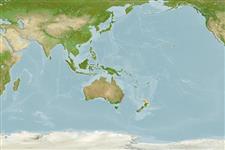Teleostei (teleosts) >
Eupercaria/misc (Various families in series Eupercaria) >
Labridae (Wrasses)
Etymology: Notolabrus: Greek, noton = back + Greek, labros = voracious (Ref. 45335); gymnogenis: Specific epithet a combination of the Greek 'gymnos' meaning bare and 'genys' meaning cheek, referring to the almost naked cheeks, with only a single row of scales.
More on author: Günther.
Environment: milieu / climate zone / depth range / distribution range
Ecology
Marine; reef-associated; depth range 5 - 40 m (Ref. 75154). Temperate
Southwest Pacific: known only from southern Queensland and New South Wales and Lord Howe Island.
Size / Weight / Age
Maturity: Lm ? range ? - ? cm
Max length : 23.0 cm SL male/unsexed; (Ref. 26203); 20.0 cm SL (female)
A common coastal reef fish collected from 15 m but may occur much deeper than this (Ref. 26203).
Life cycle and mating behavior
Maturity | Reproduction | Spawning | Eggs | Fecundity | Larvae
Oviparous, distinct pairing during breeding (Ref. 205).
Russell, B.C., 1988. Revision of the labrid fish genus Pseudolabrus and allied genera. Rec. Aust. Mus. (Suppl. 9):1-72. (Ref. 26203)
IUCN Red List Status (Ref. 130435: Version 2024-1)
Threat to humans
Harmless
Human uses
Gamefish: yes
Tools
Special reports
Download XML
Internet sources
Estimates based on models
Preferred temperature (Ref.
123201): 18.9 - 23.2, mean 21.1 °C (based on 12 cells).
Phylogenetic diversity index (Ref.
82804): PD
50 = 0.5078 [Uniqueness, from 0.5 = low to 2.0 = high].
Bayesian length-weight: a=0.01995 (0.00926 - 0.04297), b=2.99 (2.79 - 3.19), in cm total length, based on LWR estimates for this (Sub)family-body shape (Ref.
93245).
Trophic level (Ref.
69278): 3.5 ±0.5 se; based on size and trophs of closest relatives
Resilience (Ref.
120179): Medium, minimum population doubling time 1.4 - 4.4 years (Preliminary K or Fecundity.).
Fishing Vulnerability (Ref.
59153): Low vulnerability (18 of 100).
Nutrients (Ref.
124155): Calcium = 20.3 [8.5, 36.7] mg/100g; Iron = 0.207 [0.102, 0.465] mg/100g; Protein = 18.3 [15.5, 20.7] %; Omega3 = 0.295 [0.151, 0.602] g/100g; Selenium = 6.09 [2.66, 13.91] μg/100g; VitaminA = 59.4 [12.5, 379.4] μg/100g; Zinc = 0.635 [0.387, 1.229] mg/100g (wet weight);
